Delphi Study: Implementation Plan for Reconstituting Tertiary College
VerifiedAdded on 2019/10/31
|13
|3101
|147
Report
AI Summary
This assignment outlines an implementation plan derived from a Delphi study, focusing on reconstituting an Indian tertiary college. It begins with a vision statement that emphasizes the integration of ICT in all educational processes, including online studies and the use of interactive technologies. The report then conducts a stakeholder analysis, identifying students, teachers, management, and the community as key stakeholders, highlighting the benefits of ICT integration for improved learning and management. A socio-ecosystem analysis compares the current state of the college with the vision, pinpointing the need for changes in curriculum, pedagogy, and technology. The assignment projects the institution's evolution over 1, 5, and 10 years, detailing strategies for stakeholder alignment and change levers, including sensitization programs, benchmark studies, and government policies. The report concludes with a plan for change management, proposing actions such as employing government incentives and requesting development funds to achieve the college's goals. The goal is to enhance the college's educational and administrative processes by integrating ICT effectively.

Running Head: DELPHI STUDIES 1
Implementation Plan
Student’s Name
Institutional Affiliation
Date of Submission
Implementation Plan
Student’s Name
Institutional Affiliation
Date of Submission
Paraphrase This Document
Need a fresh take? Get an instant paraphrase of this document with our AI Paraphraser

DELPHI STUDIES 2
Introduction
This particular assignment involves the development of an implementation plan majorly
for the purpose of reconstituting an Indian Tertiary College. With consideration of the
institution’s level of technology, pedagogy, as well as the curriculum, we shall develop a vision
statement from the same. A vision statement, in this case, illustrates some of the issues that
would explain the manner in which the preferred institute should look like after a successful
implementation process. In the vision statement, a well thought out procedure is provided
including the strategies that would be undertaken to ensure that the institution attains its full
development potential. Following the vision statement is the stakeholder analysis. This analysis
takes into account all the stakeholders including the parents, students, staff, and the organization
itself. After the stakeholder analysis is the socio-ecosystem analysis. Such an analysis is
performed with regards to the organization in question. The difference between the institution’s
existing socio-ecosystem and vision are then identified after which changes that would be
required in curriculum, pedagogy, and technology assessment for the purpose of achieving the
organization’s vision are identified. Later on, this assignment will identify the Socio-Ecosystem
preferred for the institution with regards to changes likely to occur in:
1. 1 year
2. 5 years
3. 10 years
This assignment will also determine the change levers as well as the strategies for stakeholder
alignment. Afterwards, the activity will identify strategies that would otherwise help in attaining
Introduction
This particular assignment involves the development of an implementation plan majorly
for the purpose of reconstituting an Indian Tertiary College. With consideration of the
institution’s level of technology, pedagogy, as well as the curriculum, we shall develop a vision
statement from the same. A vision statement, in this case, illustrates some of the issues that
would explain the manner in which the preferred institute should look like after a successful
implementation process. In the vision statement, a well thought out procedure is provided
including the strategies that would be undertaken to ensure that the institution attains its full
development potential. Following the vision statement is the stakeholder analysis. This analysis
takes into account all the stakeholders including the parents, students, staff, and the organization
itself. After the stakeholder analysis is the socio-ecosystem analysis. Such an analysis is
performed with regards to the organization in question. The difference between the institution’s
existing socio-ecosystem and vision are then identified after which changes that would be
required in curriculum, pedagogy, and technology assessment for the purpose of achieving the
organization’s vision are identified. Later on, this assignment will identify the Socio-Ecosystem
preferred for the institution with regards to changes likely to occur in:
1. 1 year
2. 5 years
3. 10 years
This assignment will also determine the change levers as well as the strategies for stakeholder
alignment. Afterwards, the activity will identify strategies that would otherwise help in attaining
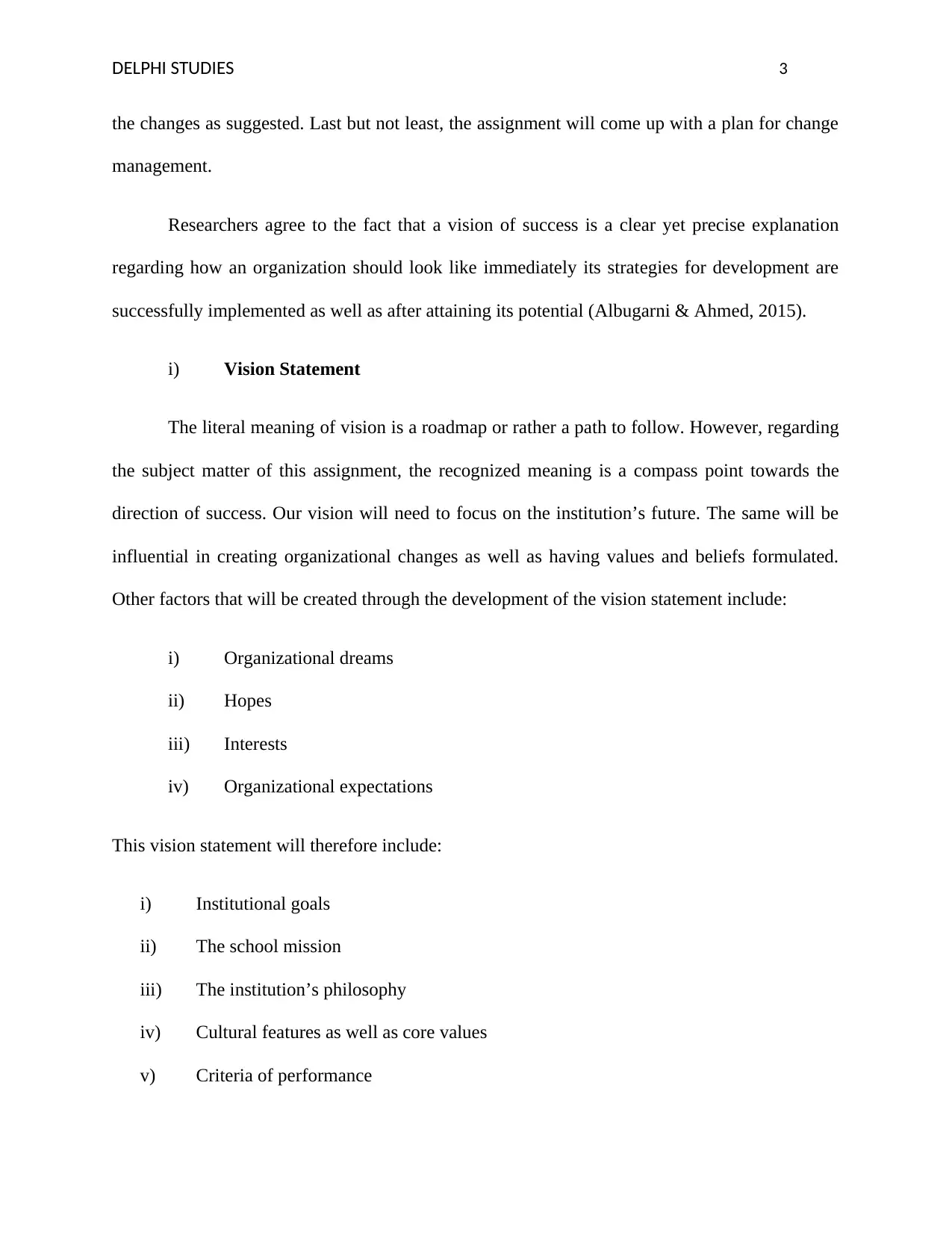
DELPHI STUDIES 3
the changes as suggested. Last but not least, the assignment will come up with a plan for change
management.
Researchers agree to the fact that a vision of success is a clear yet precise explanation
regarding how an organization should look like immediately its strategies for development are
successfully implemented as well as after attaining its potential (Albugarni & Ahmed, 2015).
i) Vision Statement
The literal meaning of vision is a roadmap or rather a path to follow. However, regarding
the subject matter of this assignment, the recognized meaning is a compass point towards the
direction of success. Our vision will need to focus on the institution’s future. The same will be
influential in creating organizational changes as well as having values and beliefs formulated.
Other factors that will be created through the development of the vision statement include:
i) Organizational dreams
ii) Hopes
iii) Interests
iv) Organizational expectations
This vision statement will therefore include:
i) Institutional goals
ii) The school mission
iii) The institution’s philosophy
iv) Cultural features as well as core values
v) Criteria of performance
the changes as suggested. Last but not least, the assignment will come up with a plan for change
management.
Researchers agree to the fact that a vision of success is a clear yet precise explanation
regarding how an organization should look like immediately its strategies for development are
successfully implemented as well as after attaining its potential (Albugarni & Ahmed, 2015).
i) Vision Statement
The literal meaning of vision is a roadmap or rather a path to follow. However, regarding
the subject matter of this assignment, the recognized meaning is a compass point towards the
direction of success. Our vision will need to focus on the institution’s future. The same will be
influential in creating organizational changes as well as having values and beliefs formulated.
Other factors that will be created through the development of the vision statement include:
i) Organizational dreams
ii) Hopes
iii) Interests
iv) Organizational expectations
This vision statement will therefore include:
i) Institutional goals
ii) The school mission
iii) The institution’s philosophy
iv) Cultural features as well as core values
v) Criteria of performance
⊘ This is a preview!⊘
Do you want full access?
Subscribe today to unlock all pages.

Trusted by 1+ million students worldwide
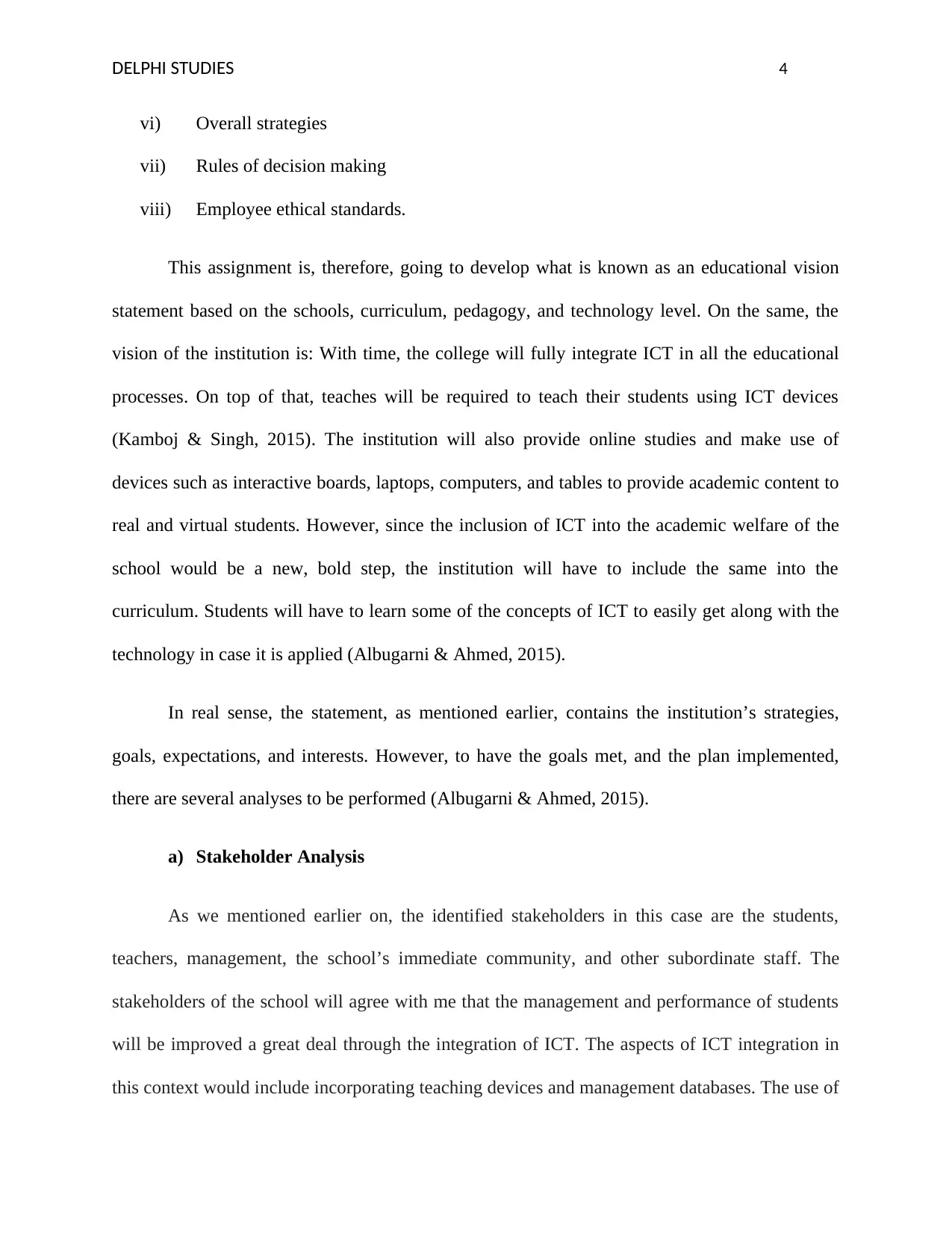
DELPHI STUDIES 4
vi) Overall strategies
vii) Rules of decision making
viii) Employee ethical standards.
This assignment is, therefore, going to develop what is known as an educational vision
statement based on the schools, curriculum, pedagogy, and technology level. On the same, the
vision of the institution is: With time, the college will fully integrate ICT in all the educational
processes. On top of that, teaches will be required to teach their students using ICT devices
(Kamboj & Singh, 2015). The institution will also provide online studies and make use of
devices such as interactive boards, laptops, computers, and tables to provide academic content to
real and virtual students. However, since the inclusion of ICT into the academic welfare of the
school would be a new, bold step, the institution will have to include the same into the
curriculum. Students will have to learn some of the concepts of ICT to easily get along with the
technology in case it is applied (Albugarni & Ahmed, 2015).
In real sense, the statement, as mentioned earlier, contains the institution’s strategies,
goals, expectations, and interests. However, to have the goals met, and the plan implemented,
there are several analyses to be performed (Albugarni & Ahmed, 2015).
a) Stakeholder Analysis
As we mentioned earlier on, the identified stakeholders in this case are the students,
teachers, management, the school’s immediate community, and other subordinate staff. The
stakeholders of the school will agree with me that the management and performance of students
will be improved a great deal through the integration of ICT. The aspects of ICT integration in
this context would include incorporating teaching devices and management databases. The use of
vi) Overall strategies
vii) Rules of decision making
viii) Employee ethical standards.
This assignment is, therefore, going to develop what is known as an educational vision
statement based on the schools, curriculum, pedagogy, and technology level. On the same, the
vision of the institution is: With time, the college will fully integrate ICT in all the educational
processes. On top of that, teaches will be required to teach their students using ICT devices
(Kamboj & Singh, 2015). The institution will also provide online studies and make use of
devices such as interactive boards, laptops, computers, and tables to provide academic content to
real and virtual students. However, since the inclusion of ICT into the academic welfare of the
school would be a new, bold step, the institution will have to include the same into the
curriculum. Students will have to learn some of the concepts of ICT to easily get along with the
technology in case it is applied (Albugarni & Ahmed, 2015).
In real sense, the statement, as mentioned earlier, contains the institution’s strategies,
goals, expectations, and interests. However, to have the goals met, and the plan implemented,
there are several analyses to be performed (Albugarni & Ahmed, 2015).
a) Stakeholder Analysis
As we mentioned earlier on, the identified stakeholders in this case are the students,
teachers, management, the school’s immediate community, and other subordinate staff. The
stakeholders of the school will agree with me that the management and performance of students
will be improved a great deal through the integration of ICT. The aspects of ICT integration in
this context would include incorporating teaching devices and management databases. The use of
Paraphrase This Document
Need a fresh take? Get an instant paraphrase of this document with our AI Paraphraser

DELPHI STUDIES 5
laptops, tablets, and teaching tutorials or models will make the whole learning process engaging
and interesting for the students as well as the lecturers (Bingimlas, 2009). Several studies on the
same, acknowledges the fact that ICT forms the backbone under which students are molded to be
able to fight for jobs in the international market. Particularly, through employment of innovative
and interactive techniques of teaching will boost the performance of students. Some of these
techniques include computer assisted instructions, computer aided designs, and audio-visual aids.
With the onset of this digital age, all the processes of learning and management need to be
engaging and digitalized (Bingimlas, 2009).
Regarding the introduction of online education, the stakeholders will confirm with me
that the platform will introduce flexibility for the lecturers and the students. Since the teaching
process is remotely achieved from any place as long as the involved parties have access to an
internet connection and a computer system, students and lecturers will not necessarily have to be
within the school premises to attend lectures. In addition, the lecture processes can as well be
recorded and given to students. Students can then go through the same as much as possible to
understand the contents and the concepts. Lecturers also have the chance to reduce their
workload by just recording the lectures.
However, regarding management, the employment of a database management system will
ensure that data is kept safe. Regarding the development of a HR (Human Resource)
management framework, a professional and excellent staff will only get constituted if the
institution develops a good framework of human resource (Roy, 2012). It is the department of
the HR that will ensure that ICT experts are recruited trained with regards to the statutes of the
institution, motivated, and performance appraisals maintained. However, all this will be achieved
laptops, tablets, and teaching tutorials or models will make the whole learning process engaging
and interesting for the students as well as the lecturers (Bingimlas, 2009). Several studies on the
same, acknowledges the fact that ICT forms the backbone under which students are molded to be
able to fight for jobs in the international market. Particularly, through employment of innovative
and interactive techniques of teaching will boost the performance of students. Some of these
techniques include computer assisted instructions, computer aided designs, and audio-visual aids.
With the onset of this digital age, all the processes of learning and management need to be
engaging and digitalized (Bingimlas, 2009).
Regarding the introduction of online education, the stakeholders will confirm with me
that the platform will introduce flexibility for the lecturers and the students. Since the teaching
process is remotely achieved from any place as long as the involved parties have access to an
internet connection and a computer system, students and lecturers will not necessarily have to be
within the school premises to attend lectures. In addition, the lecture processes can as well be
recorded and given to students. Students can then go through the same as much as possible to
understand the contents and the concepts. Lecturers also have the chance to reduce their
workload by just recording the lectures.
However, regarding management, the employment of a database management system will
ensure that data is kept safe. Regarding the development of a HR (Human Resource)
management framework, a professional and excellent staff will only get constituted if the
institution develops a good framework of human resource (Roy, 2012). It is the department of
the HR that will ensure that ICT experts are recruited trained with regards to the statutes of the
institution, motivated, and performance appraisals maintained. However, all this will be achieved

DELPHI STUDIES 6
once the organization builds an effective administrative and management system that is
supported by a comprehensive computer information system (Roy, 2012).
Payroll Cycle
All the financial aspects including relevant methods of payment of workers would be
managed via proper cycles of payroll. With the integration of ICT, the institution will ensure that
it is able to easily monitor worker payment processes as well as its funds. Several research
activities show that such payroll cycles are able to help organizations form platforms for
financial partnerships. A payroll cycle, by definition, happens to be a financial process
completed by an organization once it ends the payment of its employees (Albugarni & Ahmed,
2015).
b) Socio-Ecosystem Analysis
The organization’s current Socio-Ecosystem is not as efficient as its technological level
of advancement would require. Very few ICT devices are employed in learning and teaching
processes. As much as the school is able to afford the equipment required, installation and
maintenance issues still arise. However, the institution uses computers to a given level
particularly in the administrative sector (Roy, 2012). On the contrary, there is only one
interactive board and some few projectors for use in special occasions. There is the need to add
more interactive boards, projectors, computers, and other teaching gears to achieve the intended
goals. The school does not offer ICT courses and thus see no need to have teachers trained on the
importance of technology. One of the issues that also arise is the low interest of students to
undertake ICT courses. Most students would prefer going for business courses to those involving
ICT. However, the institution is on the verge of rectifying the situation (Roy, 2012).
once the organization builds an effective administrative and management system that is
supported by a comprehensive computer information system (Roy, 2012).
Payroll Cycle
All the financial aspects including relevant methods of payment of workers would be
managed via proper cycles of payroll. With the integration of ICT, the institution will ensure that
it is able to easily monitor worker payment processes as well as its funds. Several research
activities show that such payroll cycles are able to help organizations form platforms for
financial partnerships. A payroll cycle, by definition, happens to be a financial process
completed by an organization once it ends the payment of its employees (Albugarni & Ahmed,
2015).
b) Socio-Ecosystem Analysis
The organization’s current Socio-Ecosystem is not as efficient as its technological level
of advancement would require. Very few ICT devices are employed in learning and teaching
processes. As much as the school is able to afford the equipment required, installation and
maintenance issues still arise. However, the institution uses computers to a given level
particularly in the administrative sector (Roy, 2012). On the contrary, there is only one
interactive board and some few projectors for use in special occasions. There is the need to add
more interactive boards, projectors, computers, and other teaching gears to achieve the intended
goals. The school does not offer ICT courses and thus see no need to have teachers trained on the
importance of technology. One of the issues that also arise is the low interest of students to
undertake ICT courses. Most students would prefer going for business courses to those involving
ICT. However, the institution is on the verge of rectifying the situation (Roy, 2012).
⊘ This is a preview!⊘
Do you want full access?
Subscribe today to unlock all pages.

Trusted by 1+ million students worldwide

DELPHI STUDIES 7
Differences between the existing Socio-Ecosystem and organizational vision
The school’s socio-ecosystem is such that the institution lacks classrooms fully equipped
with ICT gadgets. Such a situation is contrary to what the institution’s vision states. According to
the vision, the classes have interactive boards, computers, and other devices. Currently, the
school doesn’t offer ICT courses and the teachers don’t teach the same which is not in
accordance to the school’s vision. According to the vision, the future teaching and learning
process will fully integrate ICT. Currently, students prefer business courses to those of ICT.
However, as time passes by, in accordance to the vision of the school, ICT will form the
backbone of each learning process in the school. The vision also states that the institution will be
able to have ICT successfully integrated into all the processes of the organization even though
very few sectors employ the same currently.
Needed Changes
Some of the major changes required include the mentality of the stakeholders and the
organizational framework. Talking of the organizational framework, the institution needs to have
the sectors restructured to have ICT devices integrated and ready for operation. However,
regarding mentality of the stakeholders, teachers need to change their teaching strategies so that
they can incorporate technology. With technology, learning would be interesting and teaching
made easy. Students should also be enlightened on the importance of learning ICT. Each and
every stakeholder should also be enlightened regarding how much students could improve their
performance via incorporation of ICT (Kaur, 2015). On the same required changes, research
activities should be performed to determine the reactions of the parties involved. Also,
Differences between the existing Socio-Ecosystem and organizational vision
The school’s socio-ecosystem is such that the institution lacks classrooms fully equipped
with ICT gadgets. Such a situation is contrary to what the institution’s vision states. According to
the vision, the classes have interactive boards, computers, and other devices. Currently, the
school doesn’t offer ICT courses and the teachers don’t teach the same which is not in
accordance to the school’s vision. According to the vision, the future teaching and learning
process will fully integrate ICT. Currently, students prefer business courses to those of ICT.
However, as time passes by, in accordance to the vision of the school, ICT will form the
backbone of each learning process in the school. The vision also states that the institution will be
able to have ICT successfully integrated into all the processes of the organization even though
very few sectors employ the same currently.
Needed Changes
Some of the major changes required include the mentality of the stakeholders and the
organizational framework. Talking of the organizational framework, the institution needs to have
the sectors restructured to have ICT devices integrated and ready for operation. However,
regarding mentality of the stakeholders, teachers need to change their teaching strategies so that
they can incorporate technology. With technology, learning would be interesting and teaching
made easy. Students should also be enlightened on the importance of learning ICT. Each and
every stakeholder should also be enlightened regarding how much students could improve their
performance via incorporation of ICT (Kaur, 2015). On the same required changes, research
activities should be performed to determine the reactions of the parties involved. Also,
Paraphrase This Document
Need a fresh take? Get an instant paraphrase of this document with our AI Paraphraser

DELPHI STUDIES 8
benchmark studies need to be performed to determine the pros, cons, and impacts of integrating
ICT in education processes.
Preferred Institution:
i) In 1 year
In a year’s time, the school should be able to have initiated sensitization programs on the
importance of integrating ICT into the operational framework of the school including the
academic, administrative, and management aspects. The school is expected to have more
interactive boards as well.
ii) In 5 years
After five years, there should be enough ICT devices including computers, laptops,
interactive boards, projectors, and even tablets. Proper incentives including government policies
should be in place to facilitate ICT learning processes. ICT teachers should be recruited as well
as students learning the same course admitted. ICT content also need to be added to the school
curriculum.
iii) In 10 years
In ten year’s time, a lot of changes ought to be made. First and foremost, online courses
should have been introduced and efficiently offered. Again, a better database management
system should be introduced in the three sectors i.e. management, administrative, and academic.
The system would ease management of data as well as increase efficiency of operations. The
school should also be able to effectively incorporate ICT in almost all the courses offered. The
intake of ICT students should be massive. Technology should dominate every academic process.
benchmark studies need to be performed to determine the pros, cons, and impacts of integrating
ICT in education processes.
Preferred Institution:
i) In 1 year
In a year’s time, the school should be able to have initiated sensitization programs on the
importance of integrating ICT into the operational framework of the school including the
academic, administrative, and management aspects. The school is expected to have more
interactive boards as well.
ii) In 5 years
After five years, there should be enough ICT devices including computers, laptops,
interactive boards, projectors, and even tablets. Proper incentives including government policies
should be in place to facilitate ICT learning processes. ICT teachers should be recruited as well
as students learning the same course admitted. ICT content also need to be added to the school
curriculum.
iii) In 10 years
In ten year’s time, a lot of changes ought to be made. First and foremost, online courses
should have been introduced and efficiently offered. Again, a better database management
system should be introduced in the three sectors i.e. management, administrative, and academic.
The system would ease management of data as well as increase efficiency of operations. The
school should also be able to effectively incorporate ICT in almost all the courses offered. The
intake of ICT students should be massive. Technology should dominate every academic process.
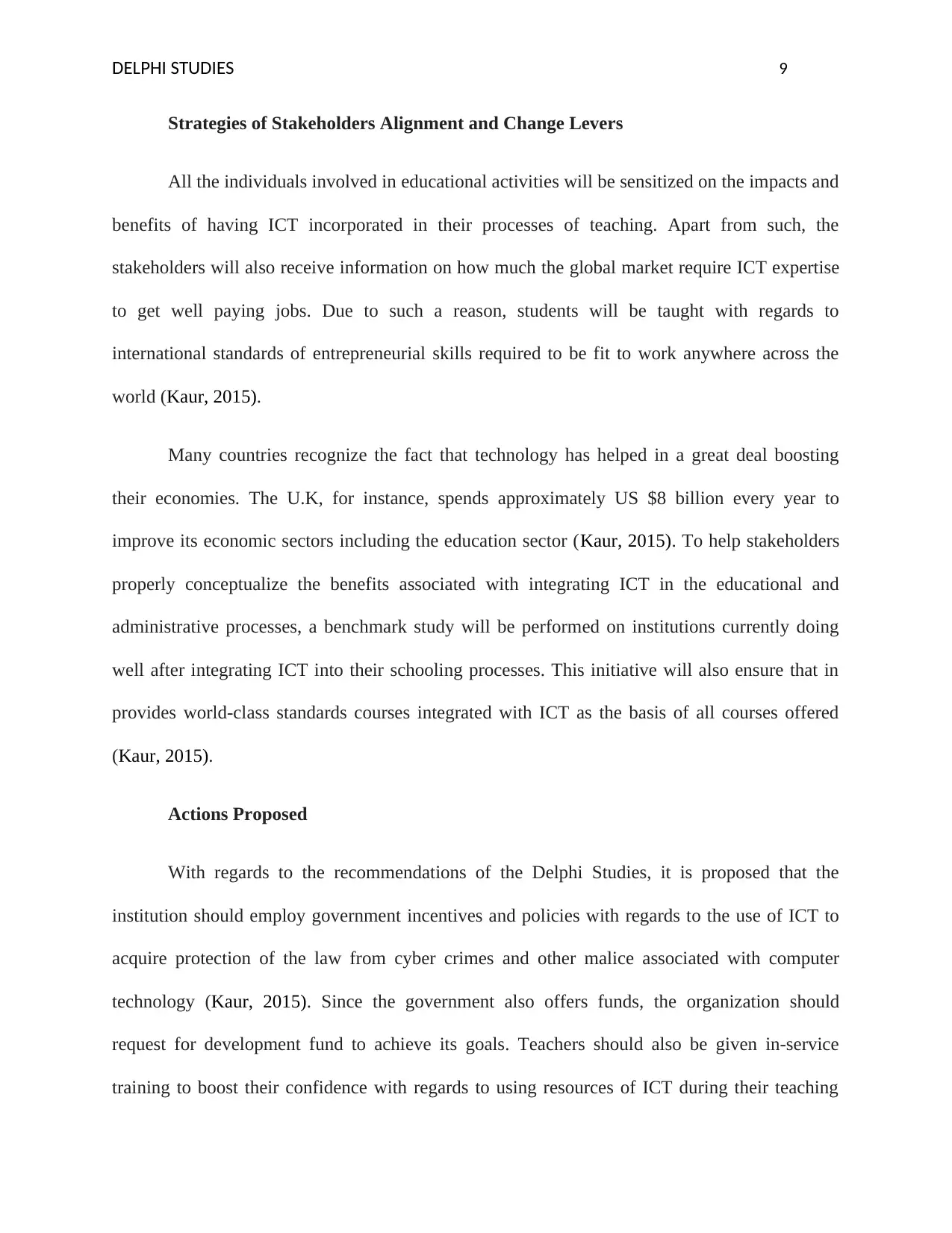
DELPHI STUDIES 9
Strategies of Stakeholders Alignment and Change Levers
All the individuals involved in educational activities will be sensitized on the impacts and
benefits of having ICT incorporated in their processes of teaching. Apart from such, the
stakeholders will also receive information on how much the global market require ICT expertise
to get well paying jobs. Due to such a reason, students will be taught with regards to
international standards of entrepreneurial skills required to be fit to work anywhere across the
world (Kaur, 2015).
Many countries recognize the fact that technology has helped in a great deal boosting
their economies. The U.K, for instance, spends approximately US $8 billion every year to
improve its economic sectors including the education sector (Kaur, 2015). To help stakeholders
properly conceptualize the benefits associated with integrating ICT in the educational and
administrative processes, a benchmark study will be performed on institutions currently doing
well after integrating ICT into their schooling processes. This initiative will also ensure that in
provides world-class standards courses integrated with ICT as the basis of all courses offered
(Kaur, 2015).
Actions Proposed
With regards to the recommendations of the Delphi Studies, it is proposed that the
institution should employ government incentives and policies with regards to the use of ICT to
acquire protection of the law from cyber crimes and other malice associated with computer
technology (Kaur, 2015). Since the government also offers funds, the organization should
request for development fund to achieve its goals. Teachers should also be given in-service
training to boost their confidence with regards to using resources of ICT during their teaching
Strategies of Stakeholders Alignment and Change Levers
All the individuals involved in educational activities will be sensitized on the impacts and
benefits of having ICT incorporated in their processes of teaching. Apart from such, the
stakeholders will also receive information on how much the global market require ICT expertise
to get well paying jobs. Due to such a reason, students will be taught with regards to
international standards of entrepreneurial skills required to be fit to work anywhere across the
world (Kaur, 2015).
Many countries recognize the fact that technology has helped in a great deal boosting
their economies. The U.K, for instance, spends approximately US $8 billion every year to
improve its economic sectors including the education sector (Kaur, 2015). To help stakeholders
properly conceptualize the benefits associated with integrating ICT in the educational and
administrative processes, a benchmark study will be performed on institutions currently doing
well after integrating ICT into their schooling processes. This initiative will also ensure that in
provides world-class standards courses integrated with ICT as the basis of all courses offered
(Kaur, 2015).
Actions Proposed
With regards to the recommendations of the Delphi Studies, it is proposed that the
institution should employ government incentives and policies with regards to the use of ICT to
acquire protection of the law from cyber crimes and other malice associated with computer
technology (Kaur, 2015). Since the government also offers funds, the organization should
request for development fund to achieve its goals. Teachers should also be given in-service
training to boost their confidence with regards to using resources of ICT during their teaching
⊘ This is a preview!⊘
Do you want full access?
Subscribe today to unlock all pages.

Trusted by 1+ million students worldwide
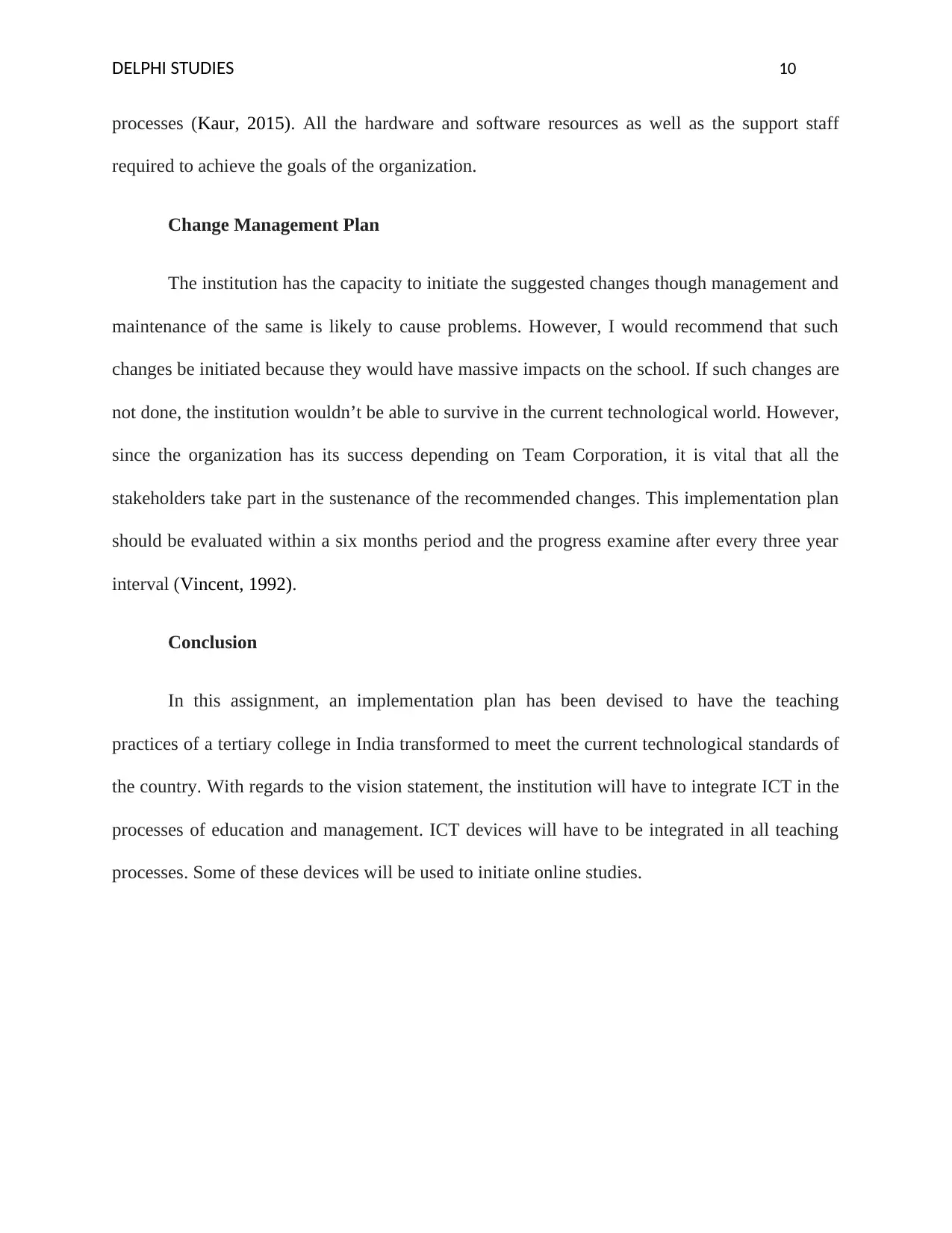
DELPHI STUDIES 10
processes (Kaur, 2015). All the hardware and software resources as well as the support staff
required to achieve the goals of the organization.
Change Management Plan
The institution has the capacity to initiate the suggested changes though management and
maintenance of the same is likely to cause problems. However, I would recommend that such
changes be initiated because they would have massive impacts on the school. If such changes are
not done, the institution wouldn’t be able to survive in the current technological world. However,
since the organization has its success depending on Team Corporation, it is vital that all the
stakeholders take part in the sustenance of the recommended changes. This implementation plan
should be evaluated within a six months period and the progress examine after every three year
interval (Vincent, 1992).
Conclusion
In this assignment, an implementation plan has been devised to have the teaching
practices of a tertiary college in India transformed to meet the current technological standards of
the country. With regards to the vision statement, the institution will have to integrate ICT in the
processes of education and management. ICT devices will have to be integrated in all teaching
processes. Some of these devices will be used to initiate online studies.
processes (Kaur, 2015). All the hardware and software resources as well as the support staff
required to achieve the goals of the organization.
Change Management Plan
The institution has the capacity to initiate the suggested changes though management and
maintenance of the same is likely to cause problems. However, I would recommend that such
changes be initiated because they would have massive impacts on the school. If such changes are
not done, the institution wouldn’t be able to survive in the current technological world. However,
since the organization has its success depending on Team Corporation, it is vital that all the
stakeholders take part in the sustenance of the recommended changes. This implementation plan
should be evaluated within a six months period and the progress examine after every three year
interval (Vincent, 1992).
Conclusion
In this assignment, an implementation plan has been devised to have the teaching
practices of a tertiary college in India transformed to meet the current technological standards of
the country. With regards to the vision statement, the institution will have to integrate ICT in the
processes of education and management. ICT devices will have to be integrated in all teaching
processes. Some of these devices will be used to initiate online studies.
Paraphrase This Document
Need a fresh take? Get an instant paraphrase of this document with our AI Paraphraser
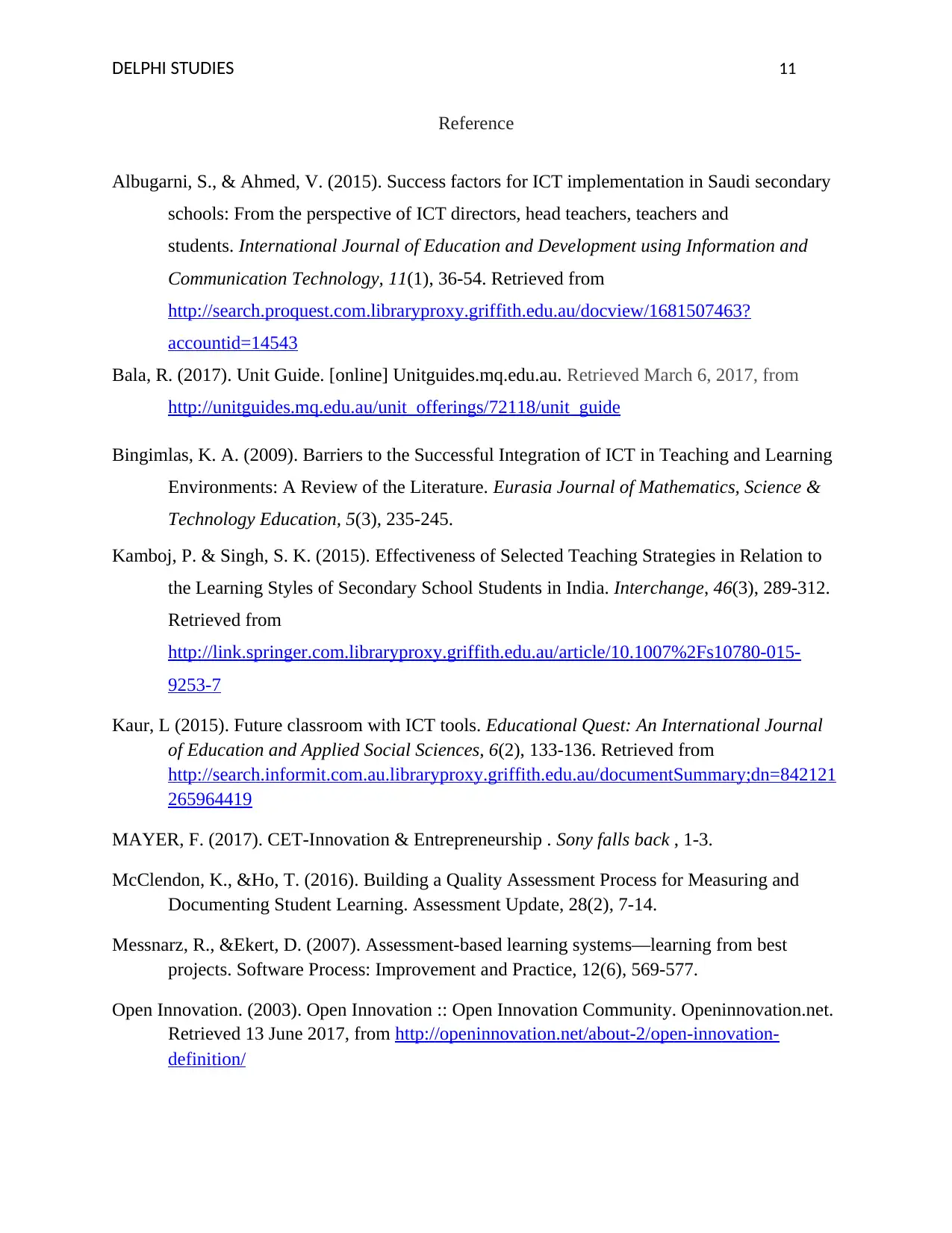
DELPHI STUDIES 11
Reference
Albugarni, S., & Ahmed, V. (2015). Success factors for ICT implementation in Saudi secondary
schools: From the perspective of ICT directors, head teachers, teachers and
students. International Journal of Education and Development using Information and
Communication Technology, 11(1), 36-54. Retrieved from
http://search.proquest.com.libraryproxy.griffith.edu.au/docview/1681507463?
accountid=14543
Bala, R. (2017). Unit Guide. [online] Unitguides.mq.edu.au. Retrieved March 6, 2017, from
http://unitguides.mq.edu.au/unit_offerings/72118/unit_guide
Bingimlas, K. A. (2009). Barriers to the Successful Integration of ICT in Teaching and Learning
Environments: A Review of the Literature. Eurasia Journal of Mathematics, Science &
Technology Education, 5(3), 235-245.
Kamboj, P. & Singh, S. K. (2015). Effectiveness of Selected Teaching Strategies in Relation to
the Learning Styles of Secondary School Students in India. Interchange, 46(3), 289-312.
Retrieved from
http://link.springer.com.libraryproxy.griffith.edu.au/article/10.1007%2Fs10780-015-
9253-7
Kaur, L (2015). Future classroom with ICT tools. Educational Quest: An International Journal
of Education and Applied Social Sciences, 6(2), 133-136. Retrieved from
http://search.informit.com.au.libraryproxy.griffith.edu.au/documentSummary;dn=842121
265964419
MAYER, F. (2017). CET-Innovation & Entrepreneurship . Sony falls back , 1-3.
McClendon, K., &Ho, T. (2016). Building a Quality Assessment Process for Measuring and
Documenting Student Learning. Assessment Update, 28(2), 7-14.
Messnarz, R., &Ekert, D. (2007). Assessment-based learning systems—learning from best
projects. Software Process: Improvement and Practice, 12(6), 569-577.
Open Innovation. (2003). Open Innovation :: Open Innovation Community. Openinnovation.net.
Retrieved 13 June 2017, from http://openinnovation.net/about-2/open-innovation-
definition/
Reference
Albugarni, S., & Ahmed, V. (2015). Success factors for ICT implementation in Saudi secondary
schools: From the perspective of ICT directors, head teachers, teachers and
students. International Journal of Education and Development using Information and
Communication Technology, 11(1), 36-54. Retrieved from
http://search.proquest.com.libraryproxy.griffith.edu.au/docview/1681507463?
accountid=14543
Bala, R. (2017). Unit Guide. [online] Unitguides.mq.edu.au. Retrieved March 6, 2017, from
http://unitguides.mq.edu.au/unit_offerings/72118/unit_guide
Bingimlas, K. A. (2009). Barriers to the Successful Integration of ICT in Teaching and Learning
Environments: A Review of the Literature. Eurasia Journal of Mathematics, Science &
Technology Education, 5(3), 235-245.
Kamboj, P. & Singh, S. K. (2015). Effectiveness of Selected Teaching Strategies in Relation to
the Learning Styles of Secondary School Students in India. Interchange, 46(3), 289-312.
Retrieved from
http://link.springer.com.libraryproxy.griffith.edu.au/article/10.1007%2Fs10780-015-
9253-7
Kaur, L (2015). Future classroom with ICT tools. Educational Quest: An International Journal
of Education and Applied Social Sciences, 6(2), 133-136. Retrieved from
http://search.informit.com.au.libraryproxy.griffith.edu.au/documentSummary;dn=842121
265964419
MAYER, F. (2017). CET-Innovation & Entrepreneurship . Sony falls back , 1-3.
McClendon, K., &Ho, T. (2016). Building a Quality Assessment Process for Measuring and
Documenting Student Learning. Assessment Update, 28(2), 7-14.
Messnarz, R., &Ekert, D. (2007). Assessment-based learning systems—learning from best
projects. Software Process: Improvement and Practice, 12(6), 569-577.
Open Innovation. (2003). Open Innovation :: Open Innovation Community. Openinnovation.net.
Retrieved 13 June 2017, from http://openinnovation.net/about-2/open-innovation-
definition/
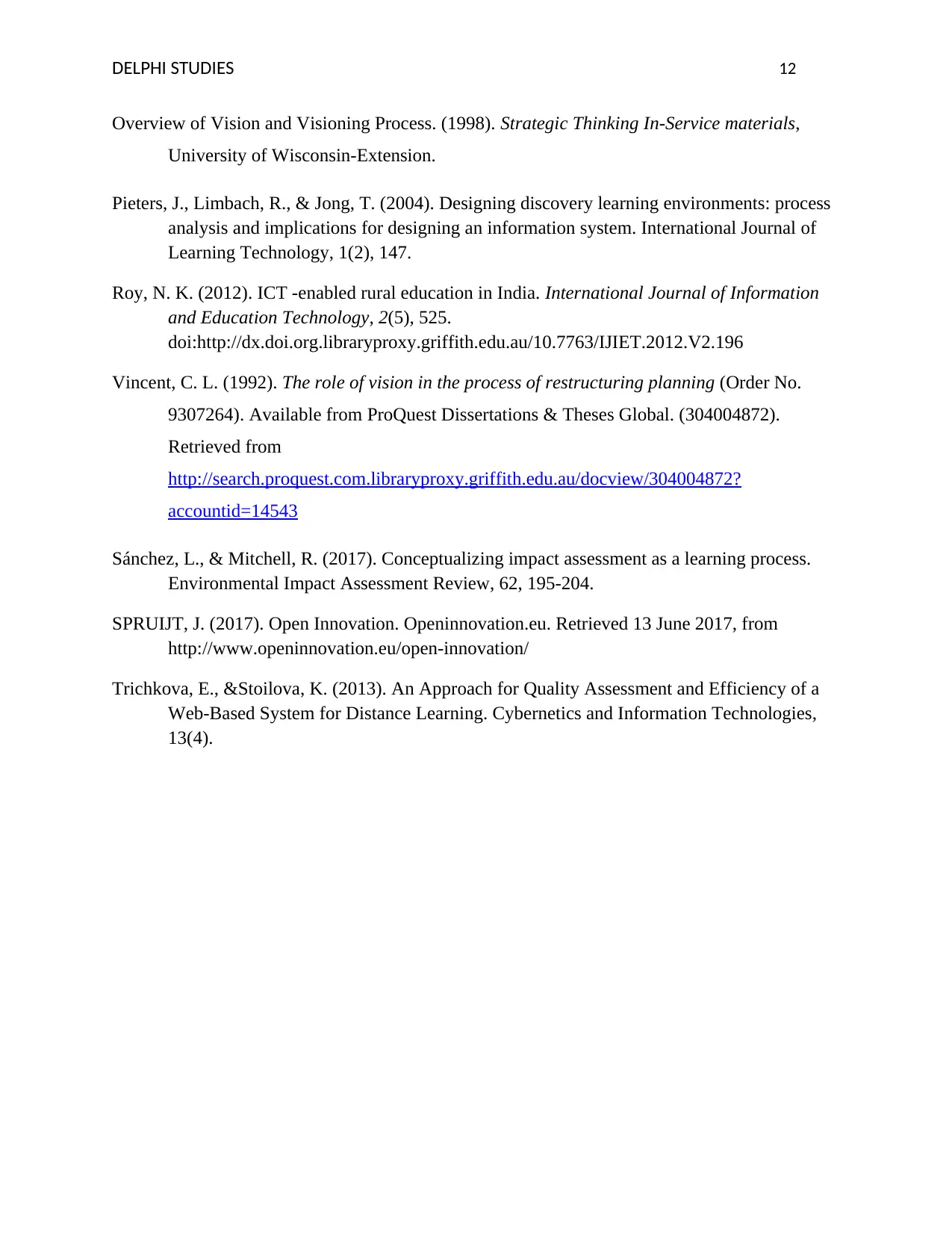
DELPHI STUDIES 12
Overview of Vision and Visioning Process. (1998). Strategic Thinking In-Service materials,
University of Wisconsin-Extension.
Pieters, J., Limbach, R., & Jong, T. (2004). Designing discovery learning environments: process
analysis and implications for designing an information system. International Journal of
Learning Technology, 1(2), 147.
Roy, N. K. (2012). ICT -enabled rural education in India. International Journal of Information
and Education Technology, 2(5), 525.
doi:http://dx.doi.org.libraryproxy.griffith.edu.au/10.7763/IJIET.2012.V2.196
Vincent, C. L. (1992). The role of vision in the process of restructuring planning (Order No.
9307264). Available from ProQuest Dissertations & Theses Global. (304004872).
Retrieved from
http://search.proquest.com.libraryproxy.griffith.edu.au/docview/304004872?
accountid=14543
Sánchez, L., & Mitchell, R. (2017). Conceptualizing impact assessment as a learning process.
Environmental Impact Assessment Review, 62, 195-204.
SPRUIJT, J. (2017). Open Innovation. Openinnovation.eu. Retrieved 13 June 2017, from
http://www.openinnovation.eu/open-innovation/
Trichkova, E., &Stoilova, K. (2013). An Approach for Quality Assessment and Efficiency of a
Web-Based System for Distance Learning. Cybernetics and Information Technologies,
13(4).
Overview of Vision and Visioning Process. (1998). Strategic Thinking In-Service materials,
University of Wisconsin-Extension.
Pieters, J., Limbach, R., & Jong, T. (2004). Designing discovery learning environments: process
analysis and implications for designing an information system. International Journal of
Learning Technology, 1(2), 147.
Roy, N. K. (2012). ICT -enabled rural education in India. International Journal of Information
and Education Technology, 2(5), 525.
doi:http://dx.doi.org.libraryproxy.griffith.edu.au/10.7763/IJIET.2012.V2.196
Vincent, C. L. (1992). The role of vision in the process of restructuring planning (Order No.
9307264). Available from ProQuest Dissertations & Theses Global. (304004872).
Retrieved from
http://search.proquest.com.libraryproxy.griffith.edu.au/docview/304004872?
accountid=14543
Sánchez, L., & Mitchell, R. (2017). Conceptualizing impact assessment as a learning process.
Environmental Impact Assessment Review, 62, 195-204.
SPRUIJT, J. (2017). Open Innovation. Openinnovation.eu. Retrieved 13 June 2017, from
http://www.openinnovation.eu/open-innovation/
Trichkova, E., &Stoilova, K. (2013). An Approach for Quality Assessment and Efficiency of a
Web-Based System for Distance Learning. Cybernetics and Information Technologies,
13(4).
⊘ This is a preview!⊘
Do you want full access?
Subscribe today to unlock all pages.

Trusted by 1+ million students worldwide
1 out of 13
Related Documents
Your All-in-One AI-Powered Toolkit for Academic Success.
+13062052269
info@desklib.com
Available 24*7 on WhatsApp / Email
![[object Object]](/_next/static/media/star-bottom.7253800d.svg)
Unlock your academic potential
Copyright © 2020–2025 A2Z Services. All Rights Reserved. Developed and managed by ZUCOL.





